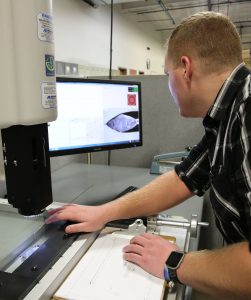 CWT’s commitment to world-class quality ensures that its products and services meet or exceed the highest standards set by all U.S. and internationally recognized agencies. Using the latest technologies in precision testing equipment, CWT continuously verifies its engineering and manufacturing processes and validates the specifications that customers demand.
CWT’s commitment to world-class quality ensures that its products and services meet or exceed the highest standards set by all U.S. and internationally recognized agencies. Using the latest technologies in precision testing equipment, CWT continuously verifies its engineering and manufacturing processes and validates the specifications that customers demand.
Because product quality depends on close attention to detail, CWT works directly with its customers to understand the end-product’s functionality, use, and requirements before developing in-depth instructions, manufacturing processes, and inspection plans.
Quality Assurance and Quality Control
Quality Assurance involves incorporating quality into every stage of a device’s production, while Quality Control involves testing product samples against their specification to guarantee consistent, high-quality output. Both are essential requirements of the medical device manufacturing line, but how can companies ensure that components they source from external suppliers follow similar standards? Let’s consider medical wire used in devices such as guidewires and catheters.
Original equipment manufacturers (OEMs) often source custom-made medical wire solutions due to specific requirements for length, diameter, and other parameters. According to Dheeraj Verma, a quality technician at CWT, the physical dimensions, mechanical properties, and appearance of the medical wire component can all affect a product’s fit, form, and function. This means the quality of the whole medical device, and ultimately the safety of the patient is at risk.
Also Read: Hypotube Trends – How Customization Leads to Medical Device Innovation
“Failure to meet the quality requirements of a component or device could cause a failure in the intended application, affecting patient safety,” Verma explains. “At CWT, we take pride in manufacturing our highest quality products by following all customer requirements. We pay attention to every detail. Our experienced engineering and quality team determines specific manufacturing processes by following all quality requirements for product conformity.”
“We have multiple layers of inspection during our manufacturing process to assure we manufacture top-quality products,” says Verma. “Quality inspection of all products is performed both during production and before shipping products to our customers. In addition, the quality department performs daily audits on manufacturing process steps to assure that the correct manufacturing processes are being followed and customer requirements met.”
Regulatory Compliance
The medical device industry has advanced remarkably over the last 50 years, and the role of quality management systems and regulations has been key to its success in developing, manufacturing, and distributing the technologies necessary for safe and effective healthcare delivery.
As a trusted ISO 13485 certified supplier of custom-made wire components and assemblies, CWT engages in open communication with its customers to understand the regulatory requirements of each product. “The benefits of maintaining ISO certification and open communication means we are meeting the requirements of the products we produce, as well as gaining the confidence of our customers that we are a partner in their success,” says Glenn Esselman, quality assurance manager at CWT.
Regulations impact the lifecycle of a medical device at every stage, from the initial development and validation of a product to the ongoing post-market surveillance. The crucial step in the middle is the premarketing submission where, in the US, a 510(k) application is made to the Food and Drug Administration (FDA). If a company intends to market their device outside of the US, they must also receive clearance from the local health authority in that jurisdiction.
“This is where matters can get complicated,” says Esselman. “It comes down to how each country deals with trying to mitigate the risk from issues that each has seen,” he explains. “The impact can be challenging for many companies launching products in multiple markets. The resources needed to keep up and comply with the various regulations can be a difficult task.”
Changing Requirements
As well as differences between jurisdictions, the regulations themselves are sometimes changed and updated. The result is a complex, constantly evolving global landscape for international medical device companies to navigate, sometimes leading to gaps in understanding.
“Due to the ever-changing needs and the new advancements of technology in the medical industry, there will always be gaps and the need for changes in regulations. Most of the time, a difference in the interpretation of a requirement creates holes or gaps. Truly understanding the correct meaning or intent of the regulation is key,” notes Esselman.
LET’S CONNECT!
To learn more about how Custom Wire technologies can serve you and your business, be sure to reach out! We look forward to hearing from you and learning how we can be of service.



